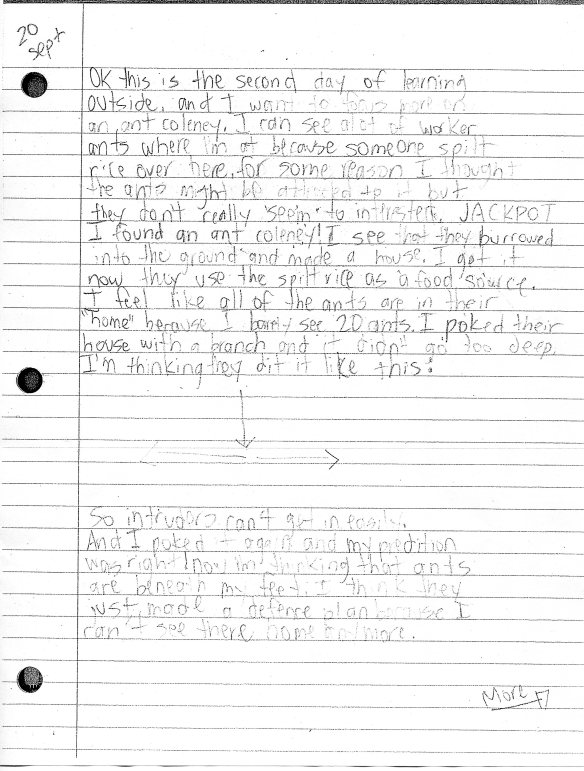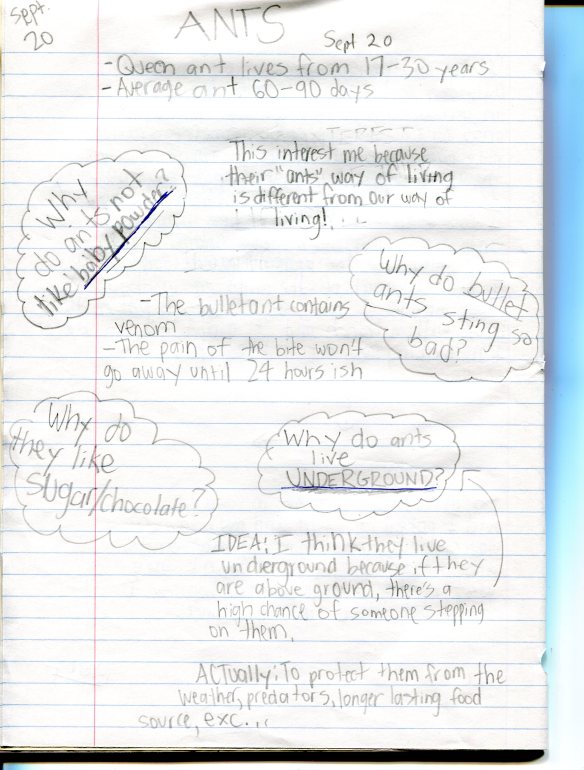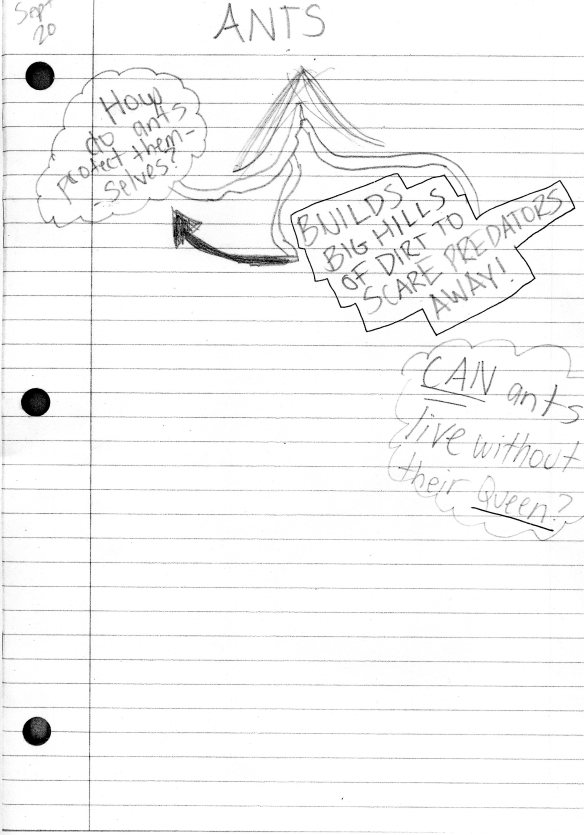A school Principal should be the principal teacher and with that in mind, two initial thoughts as the first month of school comes to a close:
- My mind is exploding with educational fireworks.
- Principal as lead teacher is an awesome job. Now if only I could get someone to do the paperwork and go to my meetings for me because both are taking away from my teaching time!
This is really Ron Berger’s fault. I’ve always believed the job of the principal is to be in the classroom as much as possible, but after reading Ethic of Excellence a few years back, the idea of experiential education became a driving force for me. Our goal as an educator should be to bring education alive for our students and this year I’m finding that happening in so many ways.
Working with our Gr. 3 and Gr. 8 teachers who are both new to the school has placed me in the middle of primary and intermediate language instruction. Together, we’re collaborating on a Language program that has proved to be invigorating. We’ve based it on the ideas of Regie Routman, Penny Kittle and Patricia Cunningham. All three are giants in literacy education and while I’m sure they’d execute the program better than we are, the important thing is that we’ve immersed our students in authentic literacy instruction (ie NO worksheets). The teachers and I are writing with the students, sharing our success and frustration, creating mini lessons on areas of need, and developing personal skills list for every student in reading and writing. The program is individualized in so many awesome ways (including personal spelling and grammar tips rather than worksheet heaven…or hell!)). Nothing revolutionary but a great opportunity to be immersed in the literacy process.
My second major foray this year has been The Beyond the Classroom program. Every year, I wonder what new thing will enthuse me. Well Beyond the Classroom has fireworks going off in my head.
For those who haven’t read the background of the problem, I’m pasting the initial three blogs below (wait till the end of this blog and if what you’ve read interests you, then I suggest you go back and click on the links below).
https://inquirenlearn.wordpress.com/2016/06/26/beyond-the-classroom-the-initial-experience/
https://inquirenlearn.wordpress.com/2016/05/10/education-should-be-exciting/
At its essence, we’re taking students outside of the classroom to learn in several different locations and immersing ourselves for 3-4 days in the structure of an organization. Let’s face it, learning is best when it’s experiential. You can talk about the costs of health care or go to Sick Kids Hospital and meet with the leaders to better understand the numbers right in front of you. You can study biodiversity from a textbook, or you can spend four days taking an in depth look at eco systems and animal life at the Toronto Zoo. You can read about the principles of flight or go to the island airport and discuss it with the experts in the field.
A key component to our program is focusing on the Catholic Graduate expectations of an Effective Communicator, Responsible citizen, Life Long Learner and Creative, Reflective and Holistic thinker. As we shared with parents at curriculum night, what better way to help prepare our children than to teach them how to communicate in an articulate, well organized manner; approach the world and their daily interactions with an eye to being responsible in all they do; continuing to learn throughout their entire life, and when it comes to the numerous issues and problems that will arise in life, approach them in a creative, reflective and most importantly a holistic way.
There are obstacles to helping a program like this succeed.
Money and time always rear their heads. How do we transport our students to the locations we’re trying to get to – From the Toronto Zoo to Sick Kids Hospital to Pearson Airport? TTC works great but it’s a significant time drain when you consider the various bus transfers we’ll need, which means we’ll need to consider the cost of school buses.
Time is an interesting idea. We are on a constant mission in our schools and classroom. Have to finish this or finish that, but what of the value of slowing down? Berger speaks to this in his work. “When I was a student in public school I turned in final draft work every hour, every day. Work was generally done in one draft, and we kept cranking it out and passing it in. Even if we cared about quality there wasn’t much we could do; we needed to get things done and passed in. One of the first things a school or classroom can do to improve the quality of student work is to get off this treadmill. This doesn’t mean an end to deadlines – the real world is full of deadlines – but rather a clear distinction between rough research, rough drafts, and finished, polished final draft work. It means final drafts may take day or weeks to complete. It means a different type of pressure; not just pressure to turn in enough work but pressure to produce something of real value.” (Berger 87 Ethic of Excellence). A key component of the Beyond the Classroom program is to slow down and learn. It’s something I’m having to learn because while I’m big on learning, slowing down is generally not in my vocabulary. It’s been a valuable and rewarding shift so far and the students are understanding this idea as well. Journaling leads to though process which leads to deeper and more critical thinking. It takes time.
Our other key obstacle is proving the worth of the program. I am convinced that we are helping to create students who will be able to look at their world in a more holistic manner but we are often asked about Data. Data? How do we provide it? How do we measure progress? Too often it comes back to scores on standardized tests. I struggle with this and maintain that if Ron Berger believes in the following statement, I can espouse it as well:
“Imagine if students and schools were judged instead on the quality of student work, thinking and character…if schools assumed they were going to be assessed by the quality of student behaviour and work evident in the hallways and classrooms- rather than on test scores, the enormous energy poured into test preparation would be directed instead toward improving student work, understanding, and behaviour. Instead of working to build clever test takers, schools would feel compelled to spend time building thoughtful students and good citizens” (Berger 102 Ethic of Excellence)
What a beautiful mind shift that would be. Sadly, there remains far too much emphasis and pressure from many sides to conform to the standard measures of learning. How farcical to base the success of a school on a three day test on math and language for two grades out of ten in an elementary school. There is no doubt that this test has some validity, but the overwhelming emphasis on it diminishes the chances of educators trying new ideas – ideas that can truly create those life long learners that are so key to excellence.
Berger goes on to say “In a time when pressure is intense, when principals and teachers are under critical siege and are being evaluated almost entirely on test scores, supporting teacher innovation and spirit is not particularly popular. The push now is to standardize, not innovate.” (Berger 142)
I know that we are far from approaching Ron Berger territory in our work but I am pleased to say that one early success I’ve noticed is how simple it can be to get our students out of the classroom and continue learning. Yes I know it’s an obvious point, but consider this. How much time in class is the teacher talking and students passively sitting? Beyond the Classroom puts onus back on the students to hone in on what interests them. We started over the last several weeks by having the students journal in different places – our school yard, downtown Toronto and sitting on Kennedy Street for a few days (15-20 minutes maximum each time).
Some of the key scaffolding we provided for students was as follows
- Time leads to notice which leads to wonder which leads to learning.
- Slow down and learn.
- When Journal writing, consider the following questions:
- What are you thinking about?
- What do you see?
- What do you hear?
- what do you notice?
- What do you wonder?
After our first few experiences, we asked our students to hone in and find their areas of interest from what they were observing. Once they did that, we pushed them to dig deeper by considering the following:
How does this topic interest me?
What questions do I have about this topic?
How can it change?
How does it affect you?
Here’s one student’s journal followed by her next steps.



As a first attempt, both the classroom teacher and I were very impressed. The level of reflection and the level of thinking from this student was most impressive. It started with her having time to consider what interested her and how she could share her learnings. A key point we’ve shared is that if a topic interests you, you will always have more questions. The world of life long learning means you never stop. How different is this from having everyone learn the same point the same way? As we’ve often heard, if you can find the answer on google, then why are you asking it?
Our first four day experience lies ahead at the Toronto zoo. For four days, our students will be honing in on areas of interests while experts speak to us about animal care, purposes of zoos, budget, animal nutrition and the role of zoo keepers.
(if you’re intrigued at this point, click on the link below to read more)
https://www.tcdsb.org/schools/stsylvester/beyondtheclassroom/Pages/default.aspx
https://www.tcdsb.org/schools/stsylvester/beyondtheclassroom/Pages/Toronto-Zoo-Experience-1.aspx
We’re not sure what to expect from the final artifact which will include student journal observations, drawings, a math connection, key wonders and questions of interest. What we do know is that we are opening ourselves to new ways of learning and exposing our students to how their personal interests are a jumping off point for deep learning. This is uncharted territory for me which is both exciting and a little anxiety causing. Having said that, I can’t think of a better way to start the school year. I know I am fortunate to be in a small school and in my third year at this school. Expectations for the school have been set together with staff, and because we’re working collaboratively with parents and students, I’m able to devote my job as a principal to the real learning (still want someone, ANYONE to take me up on a pilot project to put me back in the classroom full time for two years but that will be a topic for another day!). Barely one month in and the time seems to be flying – it always does when you’re having fun!

You are a trail blazer and innovator – If I become director (not likely) or in a position to influence, I will push for your pilot project to get you doing more teaching and teacher guiding and less paperwork! Keep doing it and it will be expected and the norm! Johan.